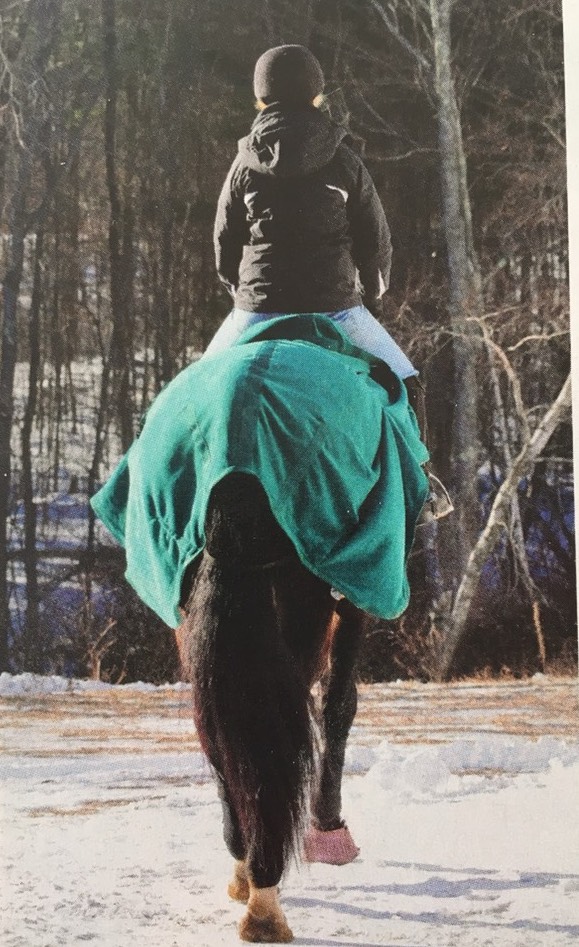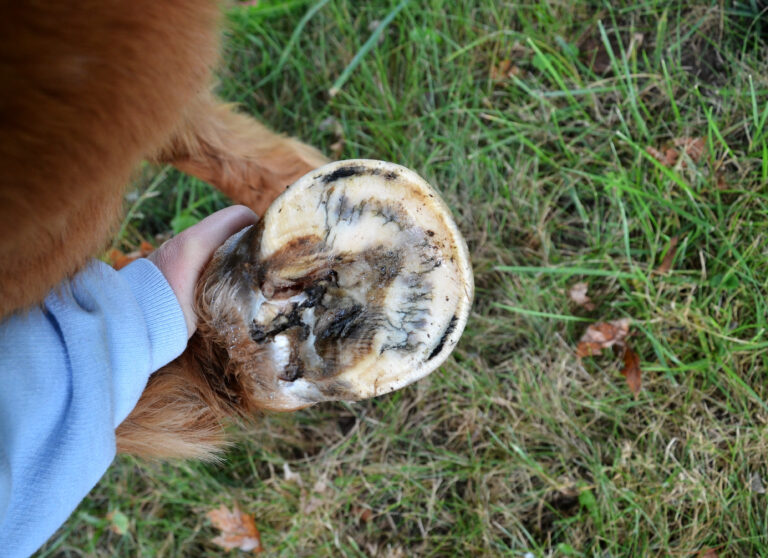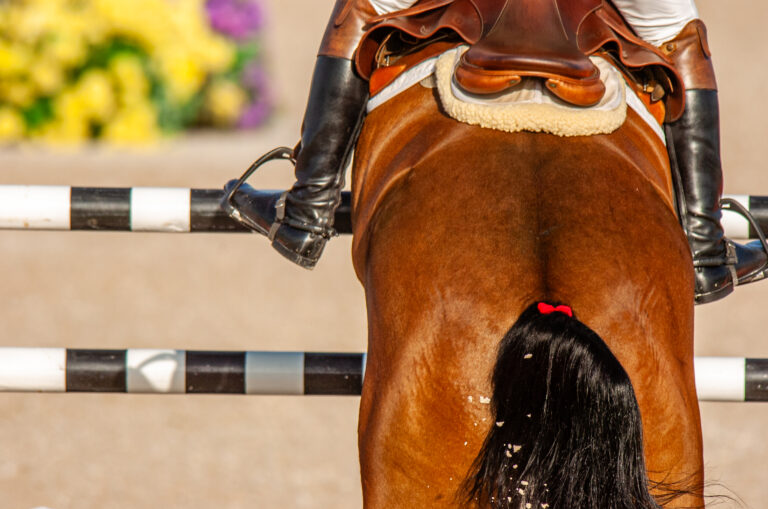Q: I’m confused by all the different options in coolers (wool, fleece, acrylic, etc.). Is one fabric better than another? And what’s the difference between a cooler and an anti-sweat sheet? Do you use them in different situations?
A: When I use the term “cooler,” I’m generally referring to a sheet or blanket that wicks moisture from a wet horse’s coat and traps heat against his body so that he doesn’t catch a chill while he dries. Coolers are handy, for example, when your horse comes in from the pasture on a cold day, soaking wet from rain or snow. Also, as the name implies, they’re great at drying a sweaty horse as he cools off after a workout. This is especially helpful with unclipped horses in the wintertime, because their long coats get sweatier during rides and take much longer to dry afterward.

If your horse is clipped, tossing a cooler on after a ride will keep him warm while his body temperature returns slowly and comfortably to normal. (During exercise, a horse’s body produces enough heat to keep him comfortable, even in cold conditions. When he stops exercising, his temperature starts to drop again. With the added effects of cold air and possibly wind, he might feel like you would jumping out of a nice, hot bath and running outside naked and wet to get the newspaper.)
Although the terms “cooler” and “anti-sweat sheet” are sometimes used interchangeably, the latter usually refers to a sheet used primarily in the summertime that wicks moisture but provides very little warmth due to its knitted structure. These sheets are made from a variety of fabrics now, but the classic anti-sweat sheet, the Irish knit, is made of 100 percent cotton and has large, ventilating holes. An anti-sweat sheet helps to dry a horse on a warm day before you put him back in his stall or turn him out. Since horses are more likely to roll when they’re sweaty and dirt and bedding stick to sweaty horses like magnets, anti-sweat sheets keep them a little cleaner.
Years ago, coolers were basically huge, woolen rectangles with a loop in the front that attached to the crown piece of the horse’s halter, a loop in the back through which you pulled his tail and either a few string closures or a metal clamp to pull the sides closed in front. These coolers shifted out of place easily and, because there was so much material between the poll and withers, they sometimes hung low enough to get stepped on, which could easily turn into a panic situation.
Coolers now come in a range of good-quality materials. Tried-and-true wool is still the warmest and most absorbent and durable fabric on the market. However, it’s generally more expensive than other fabrics and it can’t be put in the dryer. Synthetic fabrics, such as fleece, have good wicking and insulating properties, are easier to wash and dry (without risking shrinkage) and are available in many different thicknesses and colors.
Rectangular coolers are still on the market, but I recommend buying one shaped to fit your horse, more like a regular stable blanket with buckles in the front and surcingles under the belly. Some coolers even include a fitted section that covers much of the neck, either as part of the cooler or as a removable attachment.
If you’re on a budget and can only afford one cooler, choose a thickness suitable for the coldest days your region experiences. For example, if you live in an extremely cold climate, pick a heavy wool or thick fleece cooler. On less chilly days, you can modify how you use the cooler by folding it in halves or thirds and draping it over just the sweaty parts of your horse.
My rule of thumb is to use a cooler when the temperature is below about 60 degrees. This may vary somewhat depending on the weather conditions (if he’s outside) and on how wet your horse is. If it’s sunny and calm and in the upper 50s, and your horse is just barely damp, he may not need a cooler. This may not be the case for the same temperature in cloudy, drizzly conditions.
Here are some other tips and guidelines I follow when using a cooler:
1. Using a cooler during the grooming process can prevent your clipped horse from getting cold after you remove his blanket. (Again, imagine getting out of your warm, cozy bed to fetch the paper outside, naked!) It’s also handy to leave a cooler on over your tack as you begin the warm up at the walk.
2. After the exercise session, it’s sometimes necessary to put the cooler back on as you walk out your horse, so that the cooling off happens slowly. You can put it over his saddle if you’re still walking him, either mounted or unmounted. Otherwise, untack him completely before putting it on. I would rather put a cooler on a warm horse than wait for the cold air to cool him, which can cause chills.
3. Avoid panic situations: Unless your cooler has leg straps (most don’t), keep your horse tied while he’s wearing it. He can easily shift it out of place by rolling or even just by moving around a lot and trap or scare himself.
4. Leave the cooler on until your horse’s coat feels dry underneath. The cooler may be quite damp, but that means it did its job! (With some coolers, you may even see water droplets beading on the outside of the fabric.) Then remove it and blanket your horse as needed.
5. Layering. Placing a blanket over a cooler can trap moisture against your horse’s coat (because the blanket prevents wicked moisture from evaporating off the outside surface of the cooler), thus defeating the purpose of the cooler. However, if your horse is extremely wet and/or it’s an especially cold day, layering a heavier cooler over a thin, lightweight one can speed up the drying process. The heavy layer will keep your horse warm while the light layer soaks up the moisture. Be sure to check them frequently. I use a timer or alarm on my watch to remind me and remove the bottom layer before it becomes saturated (so wet that you can wring water out of it). Then replace the heavy layer and leave it on until your horse’s coat is dry.
Liv Gude is the visionary behind the Professional Equine Grooms website, which she launched last summer after her Facebook page of the same name started to grow overnight. After many years of grooming full- and part-time for several Olympians, Liv saw the need to bring professional grooms of all disciplines together in a supportive, informative community and to acknowledge them as skilled individuals, deserving of all the rights and respect that other professionals earn. The website provides everything from grooming tips to job listings and blogs. It hosts weekly contests for the best tips, tricks and tools submitted by website guests. Prizes are generously donated from several companies that share Liv’s vision to put a spotlight on the grooming profession. Liv now works full time on www.proequinegrooms.com and enjoys her Grand Prix dressage horse, Miguel, and hunter, Comet. Both horses earn their keep by posing as models for the website.
This article originally appeared in the March 2012 issue of Practical Horseman.











